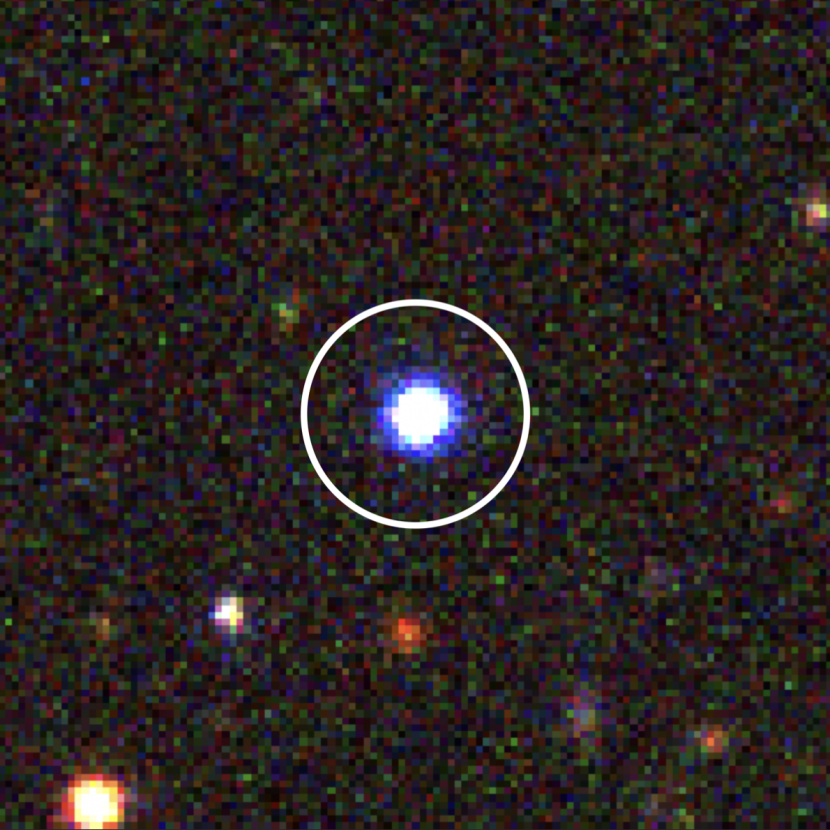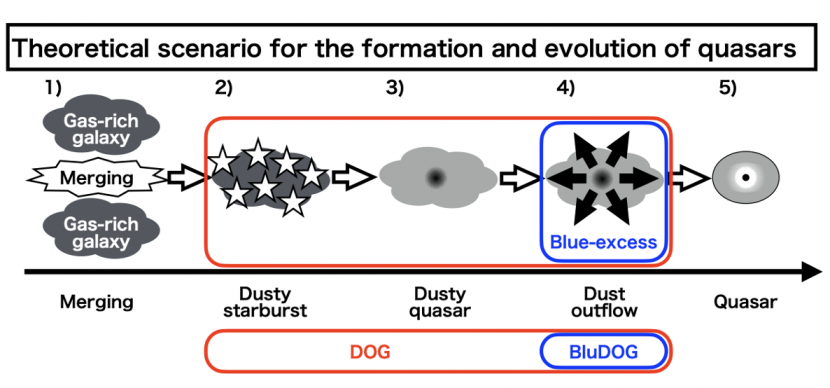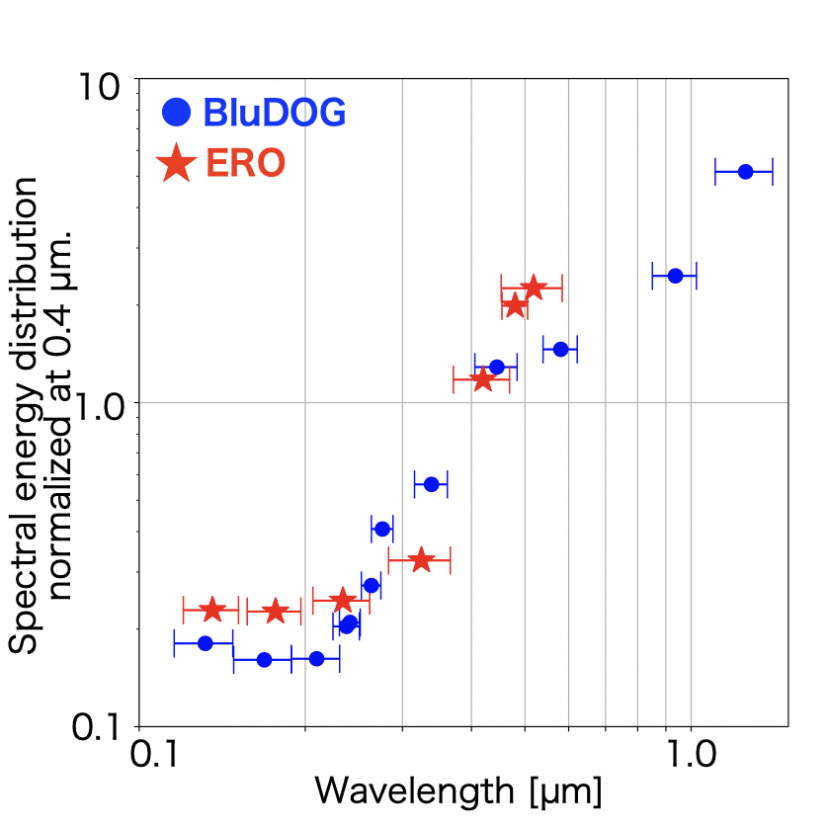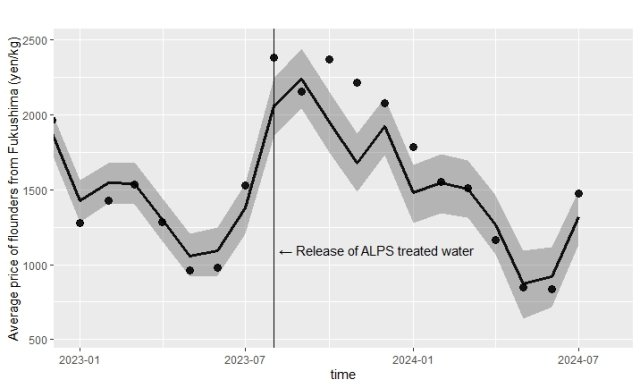BluDOGs Found in Cosmic Dawn ~Drastically growing supermassive black holes found by the Subaru telescope and JWST~
- Share
- Tweet
- Send to email
The team led by Akatoki Noboriguchi, a researcher of the Center for General Education of Shinshu University, discovered for the first time eight objects in the transition phase from dust-covered quasars to bright quasars blowing away dust and shining in visible light. The team also discovered that there are similar objects in the early universe.
【Abstract】
How quasars, celestial objects powered by supermassive black holes one billion times more massive than the Sun, formed is one of the biggest mysteries of modern astronomy. In response to this mystery, the dust-obscured galaxies (DOGs) have recently attracted attention as a possible precursor to quasars. Although theoretical scenarios expected that there would be a phase in which the large amount of dust covering DOGs is blown away for DOGs to evolve to quasars, the phase is short-lived, making the discovery of objects corresponding to this phase extremely difficult.
Our team (*1) searched for DOGs with blue-light-excess, which is a signature of the outflow phase, and found eight candidates named Blue-excess DOGs (BluDOGs; see Figure 1). In a follow-up observation, we confirmed that the blue light resembled the light of quasars, and concluded that the BluDOGs are in the dust-blowing phase. Furthermore, we were the first to notice that the spectrum of the Extremely Red Objects discovered by the James Webb Space Telescope (JWST-EROs), which began observing in 2022, is very similar to BulDOG spectrum, and compared the two populations in detail. Consequently, we conclude that JWST-EROs are the same type of objects as BluDOGs which are in the outflow phase just before becoming quasars. Thus, it is clear that the formation of quasars already began very early in the history of the universe.
The results of this research were published on December 14, 2023 (December 15, 2023 JST) in The Astrophysical Journal Letters, the journal of the American Astronomical Society.
Figure 1: An image of a BluDOG taken with Hyper Suprime-Cam on the Subaru Telescope. This is a three-color composite of the g, r, and i-band images with pseudo-colors of blue, green, and red, respectively. There is an excess of blue light in a BluDOG at the center of the image. (Credit: HSC-SSP PDR)
【§1 One of the big mysteries of modern astronomy, “How did supermassive black holes form?”】
In the Universe, there are supermassive black holes with a mass one billion times that of the Sun, and there are objects hosting these supermassive black holes called quasars. Although the birth of quasars is still unknown, one scenario is that they are triggered by mergers of gas-rich galaxies. In this scenario, there are five stages: 1) merging of gas-rich galaxies, 2) starburst obscured by dusty clouds, 3) quasar obscured by dusty clouds, 4) outflow phase blowing dusty clouds out, and 5) bright quasar (see Figure 2).
Since this is a theoretical prediction, it is necessary to verify whether this scenario is correct as an observational fact. However, since the dust-covered phase is extremely faint in visible light, it has been extremely difficult to find objects that are considered to be pre-quasars.
【§2 Dust-obscured galaxies (DOGs) as the pre-cursor to quasars】
Recently, an efficient method of searching for objects in the pre-quasar phase (equivalent to the stages 2 to 4) of the scenario has been proposed. The idea is to search for objects that are faint in visible light and bright in the mid-infrared light because the pre-quasar objects are deeply obscured by dusty clouds. These objects are called dust-obscured galaxies (DOGs). Despite the faitness in visible light, these objects corresponding to stages 2 and 3 were found by searching in visible light images obtained with a long exposure time over several tens of square degrees. However, the survey area was not large enough to find the sources, which are considered to be in the very short-lived “outflow phase” of the stage 4, just before quasars. To resolve this problem, an instrument to observe a larger area was needed.
【§3 Subaru Telescope Hyper Suprime-Cam (HSC)】
In 2014, the Subaru Telescope began a program to observe areas of the night sky totaling about 1400 square degrees using the new instrument Hyper Suprime-Cam (HSC) (the program is called HSC-SSP). In 2016, more than 100 square degrees of the observed area were ready to be used for this study and our team started the research.
【§4 DOGs and Blue-excess DOGs (BluDOGs)】
First, as in previous studies, we searched for objects that are faint in visible light and bright in mid-infrared light using the Subaru HSC-SSP optical data and mid-infrared data from the WISE satellite launched by NASA in the United States. Consequently, we found 571 DOGs in the Universe 10 to 11 billion light-years away (*2). This sample allowed us, for the first time, to search for objects in a phase where dust is being blown away by outgoing flows of material, known as outflows.
In our search for the above objects, we focused on one of the characteristics of post-evolutionary quasars: quasars which appear blue. Until now, most DOGs are thought to be red objects simply because DOGs are deeply obscured by dusty clouds. However, we thought that if the objects were in the process of evolving into quasars, they might be starting to glow blue, so we conducted a search for DOGs with a blue-excess. Consequently, we found eight objects with blue-excess and named them Blue-excess DOGs (BluDOGs; *2).
【§5 Confirming that the blue-excess of BluDOGs is the light of a quasar】
We found BluDOGs, but we needed to confirm that their blue-excesses are indeed the same as the blue light of quasars by spectroscopy (a technique in which light is divided into wavelengths). On the other hand, there was still a possibility that star-forming galaxies could also explain the blue light of BluDOGs since massive stars also emit blue light.
We therefore performed spectroscopic observations of BluDOGs using the optical spectrographs of FOCAS on the Subaru Telescope and FORS2 on the ESO-VLT. As a result, we successfully captured spectra similar to that of quasars. By analyzing the spectra, we also found that gas is flowing outward from the central nucleus. This feature was considered to be the final evolutional stage to quasars while blowing off gas and dust (*3).
【§6 There were BluDOGs farther away!!】
The James Webb Space Telescope (JWST) is making breakthroughs, and finding fainter and more distant objects than before. It found a galaxy population of extremely red objects (EROs) in the Universe 12 to 13 billion light-years away, called JWST-EROs. These objects show the characteristics of supermassive black holes and have attracted attention as a new population of objects closely related to the birth of quasars. We were the first to notice that the JWST-ERO spectra are very similar to the BluDOG spectra and compared them in detail (see Figure 3). As a result, we conclude that JWST-EROs are the same type of objects as BluDOGs which are in the outflow phase just before becoming quasars. In other words, rather than being a new population, JWST-EROs were BluDOGs at the dawn of the Universe (Published paper).
【§7 Future of BluDOG Studies】
On the other hand, we found some differences between JWST-ERO and BluDOGs. For example, the black hole mass is larger in BluDOGs and the luminosity is also larger in BluDOGs. In addition, BluDOGs are rare among DOGs, while most JWST-EROs exhibite a blue-excess. This suggests that the scale of outflows and ease of its occurrence may be different, but the details are to be studied in the future. Principal investigator Akatoki Noboriguchi (Shinshu University) says, “We hope to answer these questions by increasing the statistical number of samples and conducting more detailed spectroscopic observations in the future to clarify the mechanism of quasar birth”.
In addition, more advanced instruments in the mid-infrared will be essential to find more distant and fainter BluDOGs. An infrared space telescope project called GREX-PLUS is being planed in Japan. Professor Akio Inoue of Waseda University says, “If the space telescope project becomes reality, we expect to be able to search for such BluDOGs and to solve the mystery of the birth of BluDOGs and quasars”.
Annotation
*1: The members of the research team that conducted this study are as follows (affiliations are current at the time of publication).
Akatoki Noboriguchi, Toru Misawa (Shinshu Univ.)
Akio K. Inoue (Waseda Univ.)
Tohru Nagao, Yoshiki Matsuoka, Masaru Kajisawa, Yuichi Terashima, Mana Niida, Kodai Nobuhara, Nanako Kato, Nozomu Tamada (Ehime Univ.)
Yoshiki Toba, Yutaka Komiyama, Takuji Yamashita, Koki Terao (NAOJ)
Masafusa Onoue (IPMU)
Toshihiro Kawaguchi (Onomichi City Univ.)
Yoshihiro Ueda (Kyoto Univ.)
Kohei Ichikawa (Tohoku Univ.)
Hideo Matsuhara (JAXA)
Yu-Yen Chang (ASIAA)
*2: Paper 1
Title: Optical properties of infrared-bright dust-obscured galaxies viewed with
Subaru Hyper Suprime-Cam
Authors: Akatoki Noboriguchi, Tohru Nagao, Yoshiki Toba, Mana Niida, Masaru Kajisawa,
Masafusa Onoue, Yoshiki Matsuoka, Takuji Yamashita, Yu-Yen Chang,
Toshihiro Kawaguchi, Yutaka Komiyama, Kodai Nobuhara, Yuichi Terashima,
Yoshihiro Ueda
Publication: The Astrophysical Journal (2019, ApJ, 876, 132)
Publication date: 2019/5/13
DOI:https://doi.org/10.3847/1538-4357/ab1754
*3: Paper 2
Title: Extreme Nature of Four Blue-excess Dust-obscured Galaxies Revealed by
Optical Spectroscopy
Authors: Akatoki Noboriguchi, Tohru Nagao, Yoshiki Toba, Kohei Ichikawa, Masaru Kajisawa,
Nanako Kato, Toshihiro Kawaguchi, Hideo Matsuhara, Yoshiki Matsuoka,
Kyoko Onishi, Masafusa Onoue, Nozomu Tamada, Koki Terao, Yuichi Terashima,
Yoshihiro Ueda, Takuji Yamashita
Publication: The Astrophysical Journal (2022, ApJ, 941, 195)
Publication date: 2022/12/23
DOI:https://doi.org/10.3847/1538-4357/aca403
【Published paper】
Title: Similarity between compact extremely red objects discovered with JWST in
cosmic dawn and blue-excess dust-obscured galaxies known in cosmic noon
Authors: Akatoki Noboriguchi, Akio K. Inoue, Tohru Nagao, Yoshiki Toba, Toru Misawa
Publication: The Astrophysical Journal Letters
Publication date: 2023/12/14 (2023/12/15 JST)







